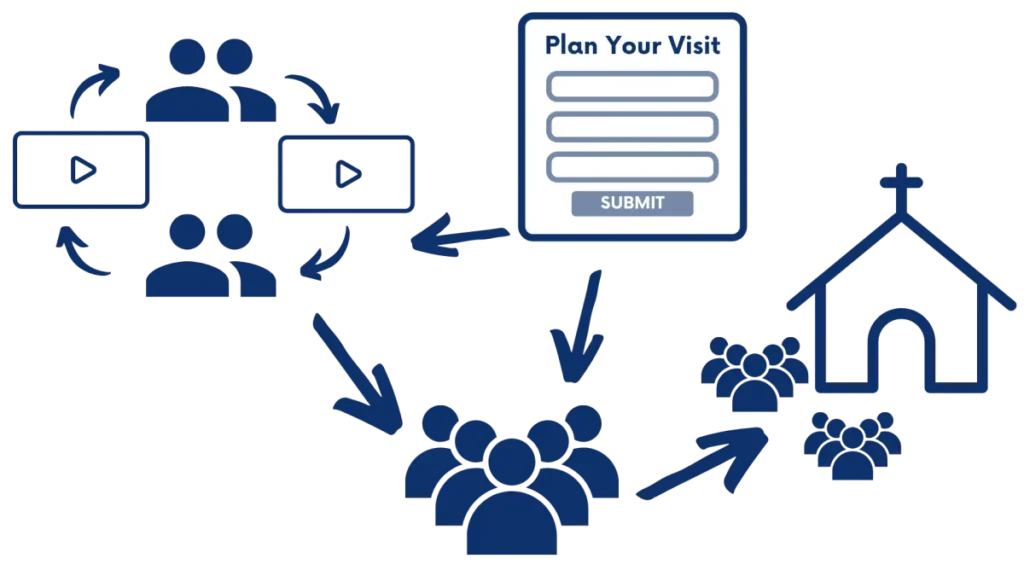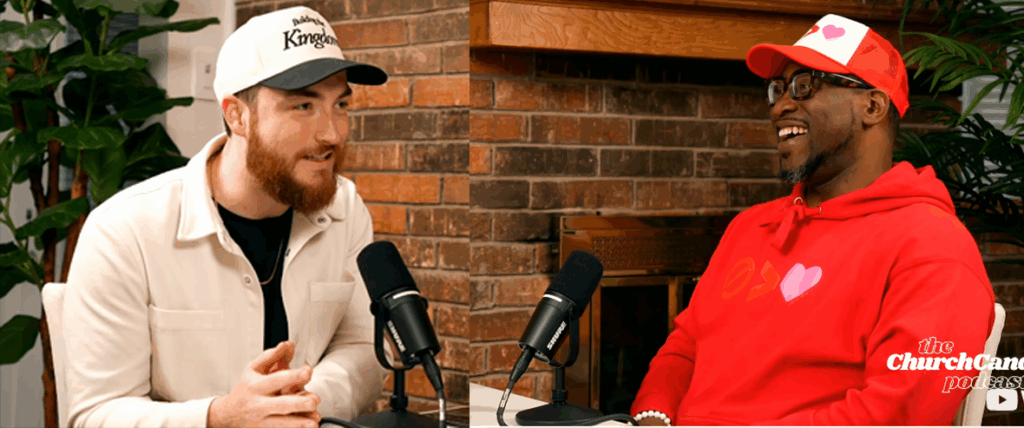
Brady Sticker joined Tim Alcorn on the Social Ground Media podcast, where they talked about what actually works when churches use paid social.
Marketers often focus on clicks, likes, and views, but Brady Sticker focuses on getting real people through church doors.
“We don’t care about likes, clicks, or impressions,” Brady told Tim.
“Our goal is to turn online views into butts in pews.”
Brady’s company, Church Candy, is a marketing agency that helps churches attract new guests using Facebook and Instagram ads.
Over 250,000 people have connected with a church because of their campaigns.
Their goal? One million.
From Chiro to Church
Tim found Brady’s origin story fascinating. “I love that it started with your dad’s agency—shows how much of this is in your blood,” he said.
Brady reveals that Church Candy started as a spinoff of Chiro Candy, his dad’s agency for chiropractors.
While studying to become a youth pastor, Brady saw a disconnect: churches needed help with digital marketing, but few knew where to begin.
“I was sitting in class, and it hit me,” he said.
“Everything we were doing for chiropractors, churches also needed.”
He dropped out of Bible college.
Had no traction that first year.
Watched his classmates walk the graduation stage without him.
But then came COVID.
“If I had gone all in sooner, the pandemic would have wiped me out,” Brady said.
“But God’s timing was perfect.”
Today, Brady shares that Church Candy has grown to a team of 30 and has helped over 1,000 churches grow.

The Ad Playbook: Plan a Visit
Tim was especially curious about the nuts and bolts. “What does it actually look like when a church hires you?” he asked.
Here’s what they do:
- Get access to the church’s ad account.
- Run local Facebook and Instagram ads.
- Ask people to “plan a visit.”
- Capture their name and number.
- Pass the lead to the church team.

Then comes the magic: retargeting.
“One guy told me, ‘Pastor Brady, I knew God was calling me to that church because your face kept showing up on my Instagram,'” Brady said. “I just smiled and said, ‘Amen.'”
Brady points out that their best-performing ads don’t look like ads at all; they blend into the feed. The slick, high-budget promos usually flop. It’s the casual selfie videos that win.
“Churches think excellence means expensive production,” Brady said.
“But excellence is clarity, not camera quality.”
Organic vs Paid? Wrong Question
Tim brought up a common question: Should churches focus on organic content or paid ads?
Brady sees churches waste time chasing TikTok views or Instagram likes.
They say they’re fulfilling the Great Commission.
But their content isn’t reaching people in their city.
“Did God call you to your city or to social media?” Brady asks.
“We help pastors reach the people actually near them.”
That said, Brady isn’t against organic.
In fact, it works with ads.
“People see the ad, then go to your profile to social proof you,” Tim added.
“If your last post is from Easter 2022 and it’s a Canva graphic, they bounce.”
Brady agreed.
“When they see the ad, they check you out,” he said.
“Then they might binge a few sermons, watch online for a few weeks, and finally show up.”
Avoid This Mistake
Tim laughed when Brady mentioned the unrealistic expectations some churches have after just one campaign. “Pastors really think Facebook is a magic wand, huh?” he joked.
One of the biggest mistakes?
Thinking social is a quick fix.
“A pastor will get 18 new families from an event ad,” Brady said.
“And they’ll say, ‘Why didn’t we get 20?'”
Another mistake: overproducing.
“We did a split test with a church,” Brady said.
“Same script. One video with a $6,000 camera. One on an iPhone. The iPhone video crushed.”
He’s seen it enough times to be sure—those raw, selfie-style vertical videos consistently outperform the polished ones.
Why?
They don’t look like ads.
Selling the Hole, Not the Drill
“You’re not pitching tools but solving real problems,” Tim said, nodding as Brady explained why they never lead with the tech or platform.
Brady expanded on this idea with a challenge to marketers: “Don’t sell the mechanics. Sell the result people actually want.”
He pointed out that most pastors don’t care how the ads work or what the click-through rate is. They care about seeing new faces on Sunday.
“Churches don’t want Facebook ads,” Brady said. “They want new families in the building. They want to make a real impact in their community.”
This mindset shift, focusing on the outcome, applies far beyond churches.
Whether you serve nonprofits, chiropractors, or HVAC companies, the principle holds:
- Nonprofits want more donors and volunteers.
- Local businesses want the phone to ring.
- Churches want their seats filled.
Brady said he’s learned to lead every sales conversation by asking, “What does success look like for you?”
That answer becomes the target. The ad platform and strategy are just tools to get there.
Tim summed it up well: “This is the difference between being a media buyer and being a real partner.”
Why It Works
One thing Brady emphasized was the power of documenting your clients’ wins not just for social proof, but for inspiration.
He brought up an example: Pastor Sherman Dumas.
Brady interviewed him on his podcast in an episode titled “How Pastor Sherman Dumas Attracted 300 Church Guests on Launch Day Using Facebook Ads.”
By capturing and sharing that story, Brady not only celebrated a successful campaign but gave other pastors a real, relatable example of what’s possible.

“There’s power in the blood of the Lamb and the word of our testimony,” Brady said.
“We use that same idea in business: share your clients’ stories.”
Tim noted that Brady is not just sharing ideas; he’s living them. The daily content, the consistent value, the transparency—it all aligns with what he teaches.
Brady proves this approach works because he follows it himself. In 2023, he posted a reel every single day.
“I give away what we do,” he said.
“Some pastors do it themselves. Some say, ‘This is too much, can you help me?'”
And staying consistent with that content? Brady says it played a huge role in his business growth.
“I got stopped at the airport by a pastor who recognized me,” Brady said.
“My wife was like, ‘Do you know him?‘ I said, ‘Nope.'”
Key Metrics
- 250,000+ people connected to a church.
- 1,000+ churches served.
- 30 team members.
- Goal: 1,000,000 people connected.
Final Word
As the conversation wrapped up, Tim asked Brady a deeper question: What does success look like to you?
His answer?
“I don’t want to be famous in the church world and unknown in my home.”
Brady’s mission is to be a good dad and husband and help churches grow.
He’s doing all three.
Check out How Brady Sticker Is Leading Church Marketing by Letting Others Tell the Story—an inside look at how he’s building authority by featuring real client success stories.
